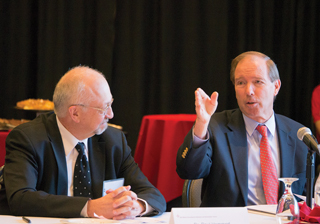
Sandia President and Laboratories Director Paul Hommert told the inaugural summit of the New Mexico Collaborative Research & Development Council that its members have the resources to advance the state’s contributions to science and technology.
“We have mechanisms in place,” Paul said. “We can use our respective strengths.”
Sandia is one of nine institutions invited by US Sens. Tom Udall and Martin Heinrich, both D-N.M., to join the council. Other members are Los Alamos National Laboratory (LANL), the University of New Mexico (UNM), New Mexico State University (NMSU), New Mexico Institute of Mining and Technology, Air Force Research Laboratory, Kirtland Air Force Base, Holloman Air Force Base and the 96th Test Group, and White Sands Missile Range.
Among those attending the meeting, in addition to Udall, Heinrich, and Paul, were UNM President Bob Frank, NMSU President Garrey
Carruthers, New Mexico Tech President Daniel Lopez, LANL Director Charlie McMillan, and Holloman AFB Commander Col. Andrew Croft.
Partnerships increasingly critical
The council encourages collaboration on research, development, test, and evaluation emphasizing critical areas related to national science and technology priorities. Udall and Heinrich said establishing and building on strategic partnerships across the state is increasingly critical as institutions face shrinking budgets and competitive funding.
“The council can help ensure that New Mexico not only retains, but enhances, its competitive position and potential for scientific contribution, economic growth, and workforce development,” Udall said.
Heinrich added, “Now more than ever we need to collaborate with the challenging fiscal constraints that exist.”
The council will meet quarterly to set goals and direct collaborative work statewide. Each member appointed two representatives to the group. Paul named VP and Chief Technology Officer Julia Phillips and Carol Adkins, director of Materials Science and Engineering Center 1800.
Julia said Sandia recently teamed with UNM to hire an individual who will work in advanced energy materials part-time at both institutions. “With this kind of collaboration we can attract people we might not be able to get by ourselves,” she said.
Paul said Sandia has R&D memoranda of understanding with UNM, NMSU, and New Mexico Tech. “We need more,” he said. “By engaging in an active dialog through the council we can take existing collaborations to a higher level.”
Udall said the state must double the number of students who graduate in science, technology, engineering, and math (STEM) fields. “Everyone here has a need for those graduates,” he said.
Paul said the state’s research universities are Sandia’s main source of hiring. “We have a shared set of equities in our success,” he said.
Commitment to economic development
UNM’s Frank said council members will commit to making the New Mexico technology corridor along the Rio Grande Valley from NMSU to LANL a national leader in R&D. “We’re making a remarkable commitment to collaborate to raise New Mexico up,” he said. “We’re prepared to lead in technology advances.”
Council members talked about the importance of creating private sector jobs. Paul said Sandia is committed to technology transfer, industry partnerships, and economic development.
Heinrich said the council “must focus on STEM and technology transfer to grow the private sector.”
“New Mexico has a proud history of scientific discovery, innovation, and technology that has long served as an engine for economic growth,” he said. “The council, whose members include some of the nation’s leading scientific minds from some of the nation’s most prestigious research institutions, will facilitate research collaborations and strategic partnerships that will allow this culture of innovation and discovery to thrive in New Mexico even during times of fiscal uncertainty.”